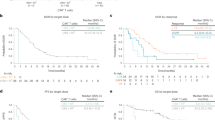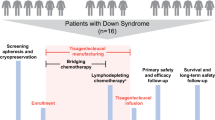Abstract
Blockade of tumor necrosis factor (TNF)α by a soluble TNF receptor fusion protein (etanercept; Enbrel) improved in vitro hemopoiesis from the marrow of patients with myelodysplastic syndrome (MDS). Therefore, we enrolled 14 MDS patients (4 RA, 2 RARS, 6 RAEB, 2 CMML), 44–80 (median 60) years old, in a pilot trial. Etanercept, 25 mg, was given twice a week s.c. for 16 weeks (increased to three times a week if no response at 8 weeks). Among 12 evaluable patients, four had rises in hemoglobin by 1–1.5 gm/dl (three) or decreased transfusion requirements (one). Two patients had increased platelet counts (54% and 73%), and two increased neutrophils (63% and 120%). Baseline TNFα levels, determined in all patients, did not correlate with responses. Among eight marrows available for sequential in vitro assays, four showed increases in CFU-GM of 1.5- to 5-fold at 8 weeks, whereas three showed 3- to 10-fold decrements relative to baseline. Thus, etanercept treatment resulted in moderate improvements of cytopenias in some patients, while cell counts declined in others. Additional trials are needed to evaluate its clinical efficacy in MDS.
This is a preview of subscription content, access via your institution
Access options
Subscribe to this journal
Receive 12 print issues and online access
$259.00 per year
only $21.58 per issue
Buy this article
- Purchase on Springer Link
- Instant access to full article PDF
Prices may be subject to local taxes which are calculated during checkout
Similar content being viewed by others
References
Mundle SD, Reza S, Ali A, Mativi Y, Shetty V, Venugopal P, Gregory SA, Raza A . Correlation of tumor necrosis factor alpha (TNF alpha) with high Caspase 3-like activity in myelodysplasticsyndromes Cancer Lett 1999 140: 201–207
Shetty V, Mundle S, Alvi S, Showel M, Broady-Robinson L, Dar S, Borok R, Showel J, Gregory S, Rifkin S, Gezer S, Parcharidou A, Venugopal P, Shah R, Hernandez B, Klein M, Alston D, Robin E, Dominquez C, Raza A . Measurement of apoptosis, proliferation and three cytokines in 46 patients with myelodysplasticsyndromes Leuk Res 1996 20: 891–900
Gersuk GM, Beckham C, Loken MR, Kiener P, Anderson JE, Farrand A, Troutt AB, Ledbetter JA, Deeg HJ . A role for tumor necrosis factor-α, Fas and Fas-Ligand in marrow failure associated with myelodysplastic syndrome Br J Haematol 1998 103: 176–188
Moreland LW, Baumgartner SW, Schiff MH, Tindall EA, Fleischmann RM, Weaver AL, Ettlinger RE, Cohen S, Koopman WJ, Mohler K, Widmer MB, Blosch CM . Treatment of rheumatoid arthritis with a recombinant human tumor necrosis factor receptor (p75)-Fc fusion protein N Engl J Med 1997 337: 141–147
Bennett JM, Catovsky D, Daniel MT, Flandrin G, Galton DAG, Gralnick HR, Sultan C The French–American–British (FAB) Co-operative Group. Proposals for the classification of the myelodysplastic syndromes Br J Haematol 1982 51: 189–199
Greenberg P, Cox C, LeBeau MM, Fenaux P, Morel P, Sanz G, Sanz M, Vallespi T, Hamblin T, Oscier D, Ohyashiki K, Toyama K, Aul C, Mufti G, Bennett J . International scoring system for evaluating prognosis in myelodysplastic syndromes (published erratum appears in Blood 1998; 91: 1100) Blood 1997 89: 2079–2088
Cheson BD, Bennett JM, Kantarjian H, Pinto A, Schiffer CA, Nimer SD, Löwenberg B, Beran M, de Witte TM, Stone RM, Mittelman M, Sanz GF, Wijermans PW, Gore S, Greenberg PL . Report of an international working group to standardize response criteria for myelodysplastic syndromes Blood 2000 96: 3671–3674
Reza S, Shetty V, Dar S, Qawi H, Raza A . Tumor necrosis factor-alpha levels decrease with anticytokine therapy in patients with myelodysplastic syndromes J Interfer Cytok Res 1998 18: 871–877
Mundle SD, Mativi BY, Bagai K, Feldman G, Cheema P, Gautam U, Reza S, Cartlidge JD, Venugopal P, Shetty V, Gregory SA, Robin E, Rifkin S, Shah R, Raza A . Spontaneous down-regulation of Fas-associated phosphatase-1 may contribute to excessive apoptosis in myelodysplastic marrows Int J Hematol 1999 70: 83–90
Acknowledgements
We thank all referring physicians, and physicians and staff caring for these patients, for their contributions. We appreciate the administrative help of Medo Schlemmer and Monina Almeda. We thank B Larson and H Crawford for typing the manuscript. This work was supported in part by grants CA87948 from the National Cancer Institute, and HL36444 from the National Heart Lung and Blood Institute, NIH, DHHS, Bethesda, MD, and by a grant-in-aid from Immunex Corp. HJD also received support from the Gabrielle Rich Leukemia Fund.
Author information
Authors and Affiliations
Rights and permissions
About this article
Cite this article
Deeg, H., Gotlib, J., Beckham, C. et al. Soluble TNF receptor fusion protein (etanercept) for the treatment of myelodysplastic syndrome: A pilot study. Leukemia 16, 162–164 (2002). https://doi.org/10.1038/sj.leu.2402356
Received:
Accepted:
Published:
Issue Date:
DOI: https://doi.org/10.1038/sj.leu.2402356



